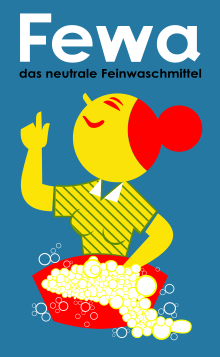Laundry detergent

Laundry detergent is a type of detergent (cleaning agent) used for cleaning dirty laundry (clothes). Laundry detergent is manufactured in powder (washing powder) and liquid form.
While powdered and liquid detergents hold roughly equal share of the worldwide laundry detergent market in terms of value, powdered detergents are sold twice as much compared to liquids in terms of volume.[1]
History

From ancient times, chemical additives were used to facilitate the mechanical washing of textile fibers with water. The earliest recorded evidence of the production of soap-like materials dates back to around 2800 BC in ancient Babylon.[2]
German chemical companies developed an
Soils
Washing laundry involves removing mixed soils from fiber surfaces. From a chemical viewpoint, soils can be grouped into:
- Water-soluble soils such as .
- Solid particulate soils such as silicates, and humus.
- Hydrophobic soils such as sebum, mineral oil, and grease.
- them into smaller parts before they can be removed by the surfactants.
- Bleachable stains such as oxidationreaction which turns the colored substance into a colorless one, which either stays on the fabric or may be easier to wash out.
Soils difficult to remove are
Components
Laundry detergents may contain builders (50% by weight, approximately), surfactants (15%), bleach (7%), enzymes (2%), soil
Builders
Builders (also called
The earliest builders were
Alkali builders may also enhance performance by changing the pH of the wash. Hydrophilic fibers like cotton will naturally have a negative surface charge in water, whereas synthetic fibers are comparatively neutral. The negative charge is further increased by the adsorption of anionic surfactants. With increasing pH, soil and fibers become more negatively charged, resulting in increased mutual repulsion. The optimum pH range for good detergency is 9–10.5.[5] Alkalis may also enhance wash performance via the saponification of fats.
Builder and surfactant work synergistically to achieve soil removal, and the washing effect of the builder may exceed that of the surfactant. With hydrophilic fibers like cotton, wool, polyamide and polyacrylonitrile, sodium triphosphate removes soil more effectively than a surfactant alone. It is expected that when washing hydrophobic fibers like polyesters and polyolefins, the effectiveness of the surfactant surpasses that of the builder, however this is not the case.[6]
Surfactants

Surfactants are responsible for most of the cleaning performance in laundry detergent. They provide this by
Laundry detergents contain mostly anionic and non-ionic surfactants. Cationic surfactants are normally incompatible with anionic detergents and have poor cleaning efficiency; they are employed only for certain special effects, as
Until the 1950s,
Since the 1970s, nonionic surfactants like
Bleaches
Despite the name, modern laundry bleaches do not include household bleach (
Enzymes
The use of enzymes for laundry was introduced in 1913 by
Enzymes are required to degrade stubborn stains composed of
Other ingredients
Many other ingredients are added depending on the expected circumstances of use. Such additives modify the
A number of ingredients affect aesthetic properties of the item to be cleaned or the detergent itself before or during use. These agents include
).Market
Worldwide, while liquid and powdered detergents hold roughly equal market share in terms of value, powdered laundry detergent is more widely used. In 2018, sales of powdered detergent measured 14 million metric tons, double that of liquids. While liquid detergent is widely used in many Western countries, powdered detergent is popular in Africa, India, China, Latin America, and other emerging markets. Powders also hold significant market share in eastern Europe and in some western European countries due to their advantage over liquids in whitening clothes. According to Desmet Ballestra, designer and builder of chemical plants and detergent-making equipment, powdered detergents have a 30–35% market share in western Europe. According to Lubrizol, the powdered detergent market is growing by 2 percent annually.[1]
Environmental concerns
Phosphates in detergent became an environmental concern in the 1950s and the subject of bans in later years.[9] Phosphates make laundry cleaner but also cause eutrophication, particularly with poor wastewater treatment.[10]
A 2013 academic study of fragranced laundry products found "more than 25 VOCs emitted from dryer vents, with the highest concentrations of acetaldehyde, acetone, and ethanol. Seven of these VOCs are classified as hazardous air pollutants (HAPs) and two as carcinogenic HAPs (acetaldehyde and benzene)".[11]
The
See also
References
- ^ a b c McCoy, Michael (27 January 2019). "Almost extinct in the US, powdered laundry detergents thrive elsewhere in the world". Chemical & Engineering News. American Chemical Society. Archived from the original on 13 December 2019. Retrieved 13 December 2019.
- ISBN 978-0-7514-0479-1. Archivedfrom the original on 20 August 2016.
The earliest recorded evidence of the production of soap-like materials dates back to around 2800 BCE in ancient Babylon.
- ^ a b Spriggs, John (July 1975), An economical of the development of substitutes with some illustrative examples and implications for the beef industry (PDF), Staff paper series, University of Minnesota, pp. 34–37, retrieved 9 May 2008
- ^ ISBN 978-3527306732
- ISBN 978-0-8247-8357-0.
- .
- .
- ^ Knud-Hansen, Chris (February 1994). "HISTORICAL PERSPECTIVE OF THE PHOSPHATE DETERGENT CONFLICT". www.colorado.edu. CONFLICT RESEARCH CONSORTIUM. Archived from the original on 28 May 2010. Retrieved 21 March 2017.
- PMID 28951681.
- ^ Anne C. Steinemann, "Chemical Emissions from Residential Dryer Vents During Use of Fragranced Laundry Products", Air Quality, Atmosphere and Health, March 2013, Vol. 6, Issue 1, pp. 151–156.


